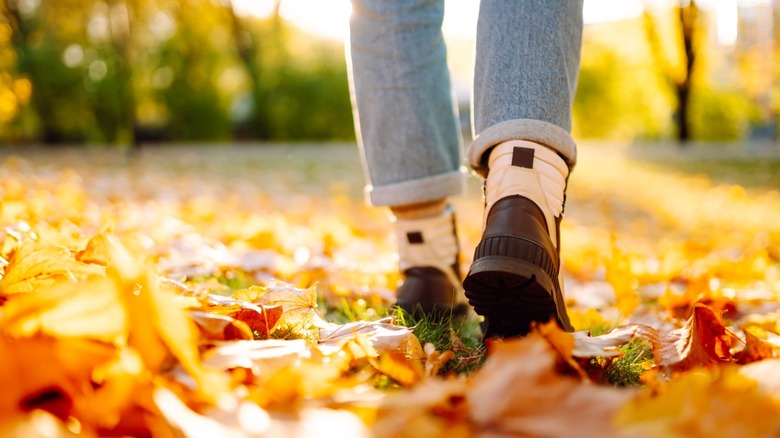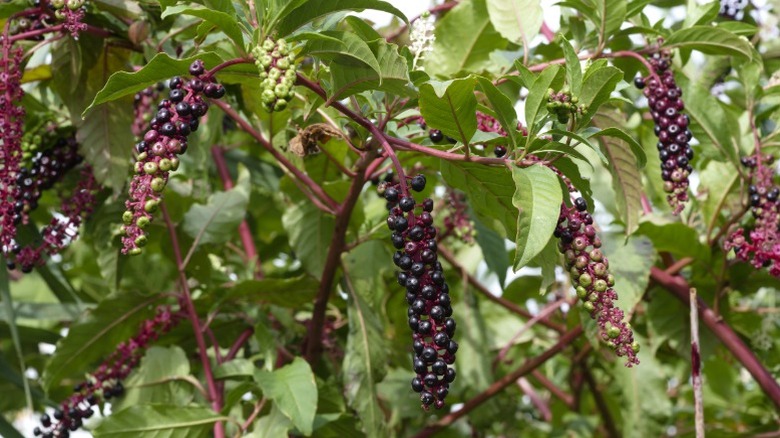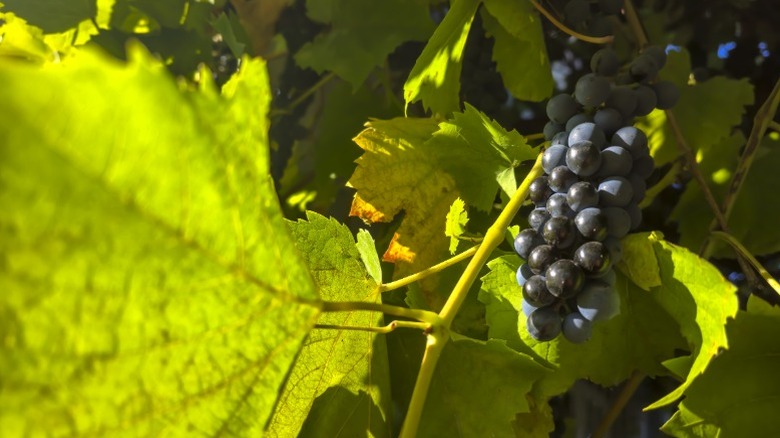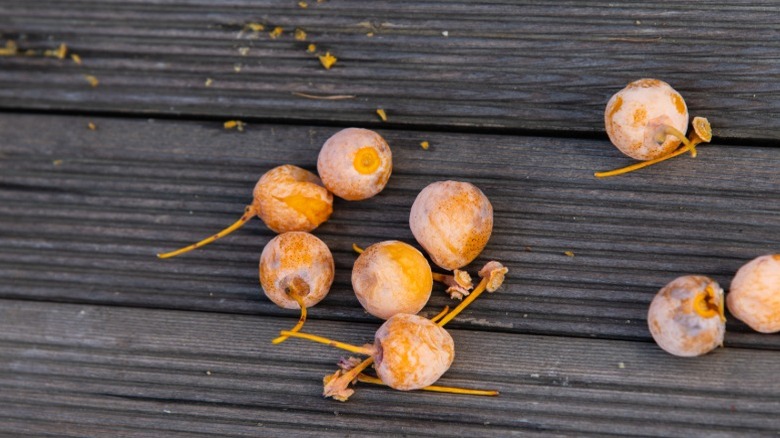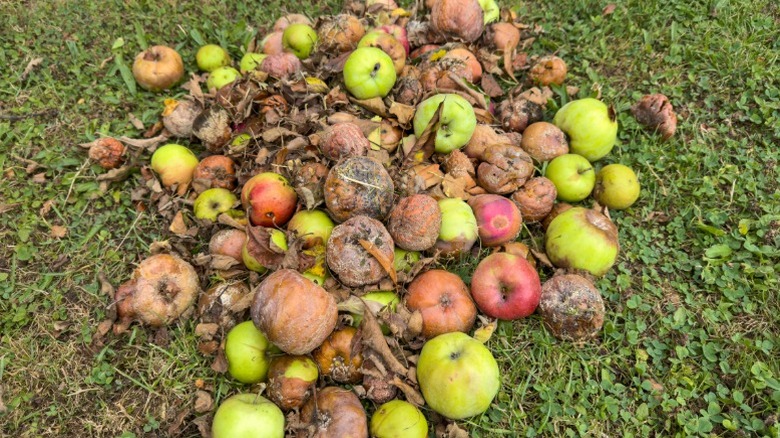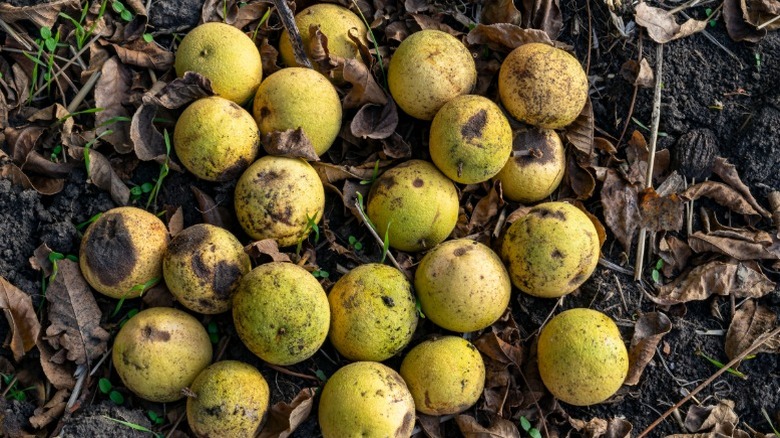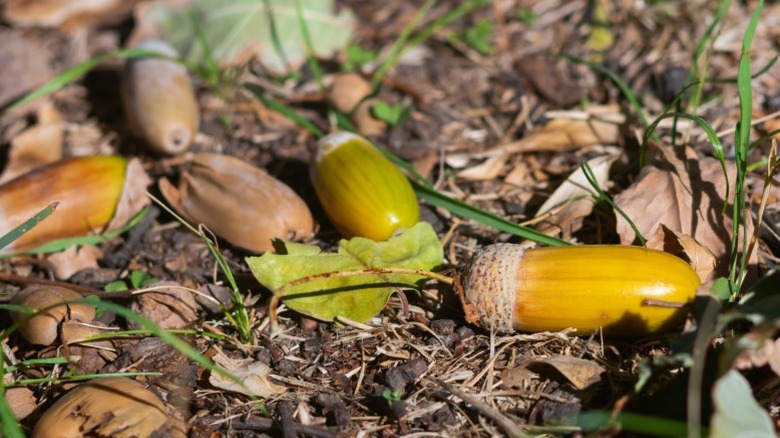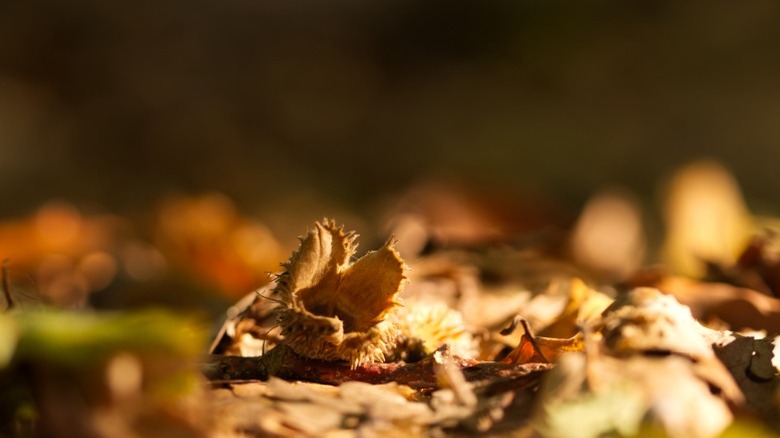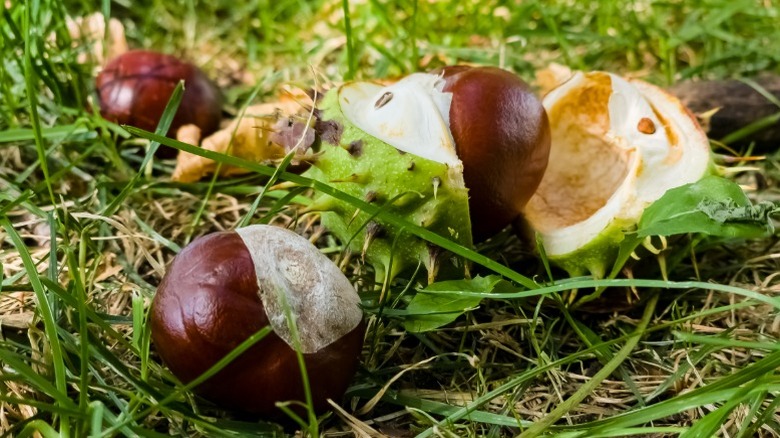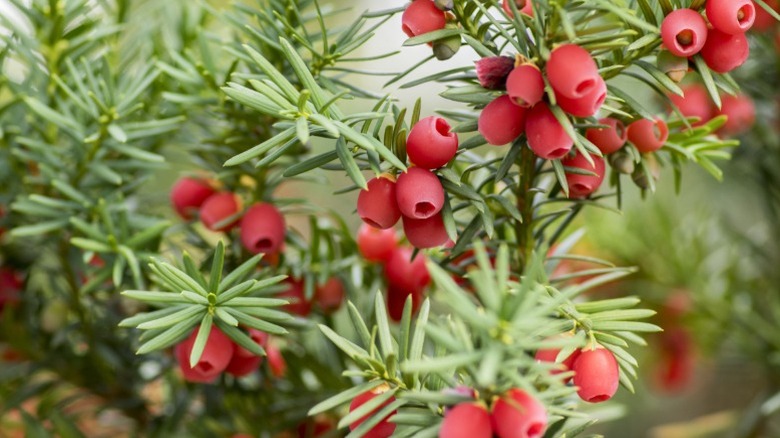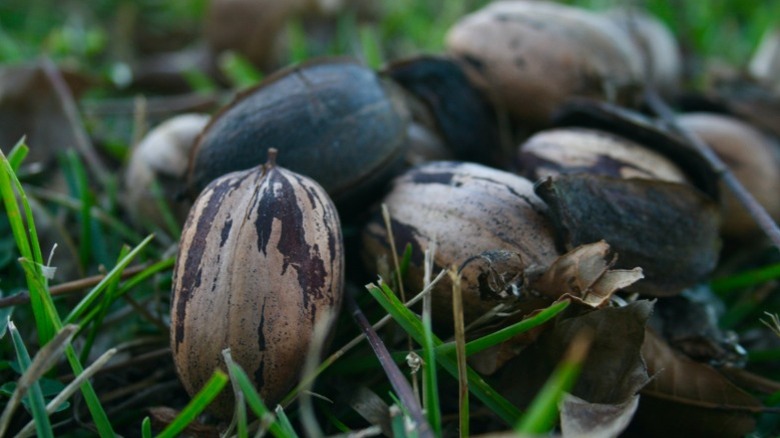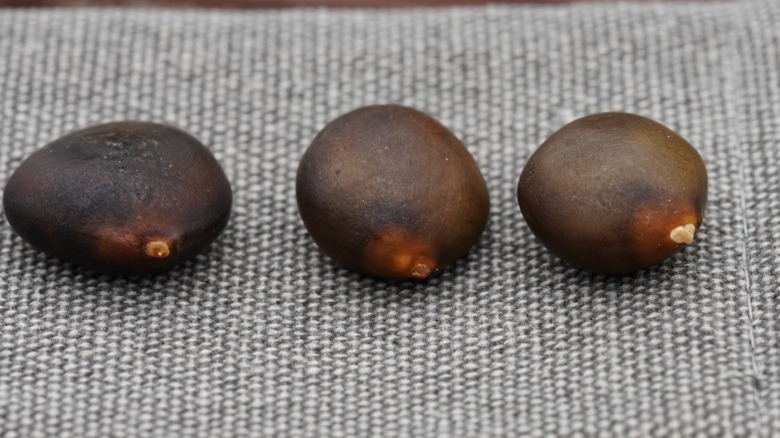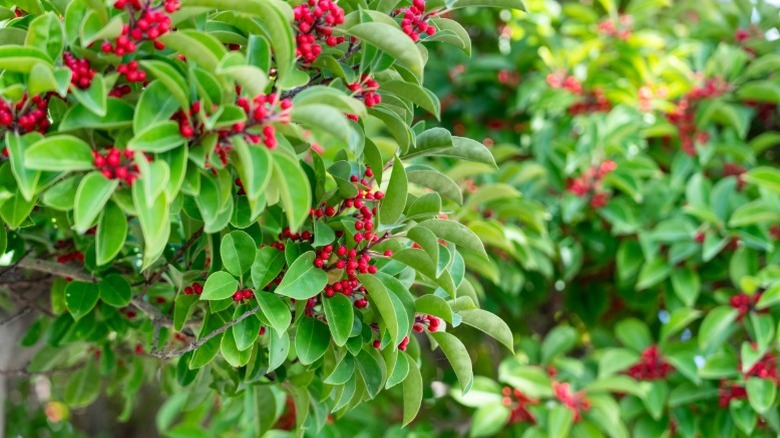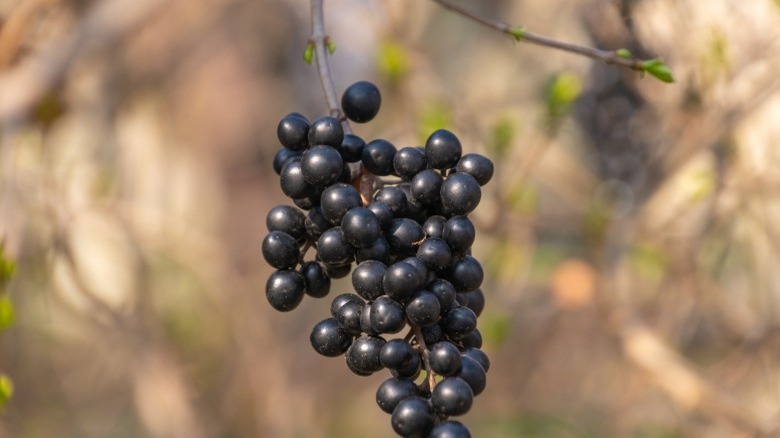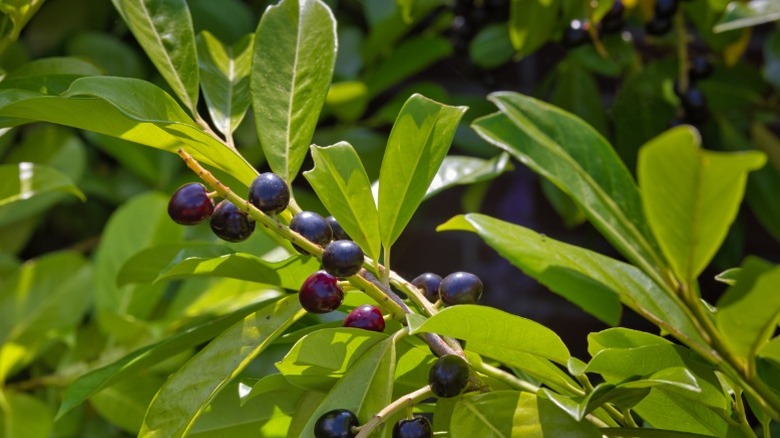14 Toxic Fruits & Nuts To Look Out For Along With Falling Leaves In The Fall
Fall is a time for falling leaves, cooler temperatures, and warm drinks. And, if you're not careful, it's also a time to avoid certain toxic fruits and nuts that litter the ground. While it's vital that everyone knows which things to look out for, it's especially true for people with children or pets. A small child or a curious dog can easily put some of these toxic fruits and nuts in their mouth before you even have the time to react.
It might not be possible to avoid these plants completely, whether they're in your yard or along a hiking trail. If you can, try not to plant any trees that litter aggressively in the fall. Some of the messiest trees you never want to plant in your yard are also ones you should avoid due to toxic fruits and nuts, like yew berries, privet berries, and acorns. But if you can't avoid them altogether, the best practice is to know how to identify anything you, your children, and your pets should absolutely not eat.
Pokeweed berries
An example of a pretty, but poisonous, berry, pokeweed (Phytolacca americana) is a native plant with aggressive tendencies. Look out for plants between 4 and 9 feet tall with green and pink stems. Despite its attraction for birds, the berries that grow on the pokeweed plant are pretty toxic. These dark berries hang off in clusters that develop into November. Check to see if any have fallen off the plant or have been dropped by birds. If you eat enough pokeweed berries, not only will your hand be stained, but you will likely experience vomiting and severe diarrhea.
Homegrown grapes
Growing grapes (Vitis spp.) in the home garden can be fun and rewarding, but be aware of the danger to your pets. Dogs who consume any number of grapes can experience kidney failure. While it's not known the exact reason why grapes are bad, it may be linked to mycotoxins or tartaric acid. From September to October, stay vigilant if you have homegrown grapes on your property, as this is when they become ripe and are ready to harvest. After the harvest period, make sure to clear debris, including leftover, fallen fruit.
Ginkgo fruit
Often described as a living fossil, the ginkgo tree (Ginkgo biloba) is native to China but grown around the world. Their beautiful, fan-shaped leaves, which turn a stunning yellow shade in the fall, are a major attraction for the landscape. However, its messy, foul-smelling fruit is one of the reasons you might not want to encounter a ginkgo tree. Ginkgo fruit is not completely inedible, but it does contain toxins that can lead to nausea and abdominal pain if eaten raw. Eating a lot of the fruit can also be dangerous. Plant male trees to avoid this toxic fruit altogether.
Apples
As fall rolls around, fruits have started to ripen. Sometimes, ripe fruit gets knocked down by the wind before it can be picked. Apples are a common windfall fruit and can be dangerous to pets if consumed in high quantities due to the presence of toxic cyanide in the seeds. Always be careful walking dogs near fallen apples. Plus, if left on the ground for too long, these tasty treats can rot and produce patulin, a type of mycotoxin produced by mold. Don't eat or let your children or pet eat apples that could be moldy or fermented.
Black walnuts
Black walnut trees (Juglans nigra) are large, sometimes 75 feet in height, and eventually produce many baseball-sized, green nuts in autumn. And if there's one thing you should know before growing a walnut tree, it's whether you want to deal with the messy fallen nuts once it reaches maturity. While squirrels and raccoons regularly munch on black walnuts, your beloved pooch cannot without severe consequences, especially if it's become moldy. The juglone compound in black walnuts can lead to seizures and tremors. Also be aware of the husks left behind from walnuts, which can contain a mycotoxin deadly for dogs.
Acorns
It's best to leave the acorns for the squirrels. Acorns drop off of oak trees (Quercus spp.) in fall, sometimes bopping people and animals on the head. The greater physical risk, however, is if dogs who try to eat them. The tannins present in acorns are a toxic compound that causes vomiting, diarrhea, and abdominal pain. Thankfully, most dogs do not eat enough for it to be an issue. But livestock, like cows, often experience much more severe consequences, including organ damage, due to extended exposure in fields. Humans should only consume acorns if they've been processed.
Beechnuts
Both the European beech (Fagus sylvatica) and the American beech (Fagus grandifolia) produce edible nuts. Both trees will drop these beechnuts after they ripen sometime in the fall. Large quantities, however, of beechnuts can be a big problem for people and pets. American beechnuts contain a little bit of saponic glycoside, which can lead to stomach upset in some people who eat too many nuts. Meanwhile, if you have the European species, those nuts contain trimethylamine and oxalic acid which can cause gastrointestinal issues in humans and dogs.
Horse chestnuts
Do not confuse these two trees that are actually unrelated. Chestnuts (Castanea spp.) include Chinese (Castanea mollissima) and American (Castanea dentata) which produce edible nuts. The horse chestnut tree (Aesculus hippocastanum), however, comes from a different genus of trees with inedible nuts. Often planted as a lovely street tree, horse chestnuts are very toxic and extremely dangerous. Eating these nuts can lead to death, with severe symptoms like muscle weakness, diarrhea, paralysis, and depression. The nuts fall off trees in prickly pods containing large brown seeds. Thankfully, its bitter taste discourages people and animals from eating them with gusto.
Yew berries
A pretty evergreen shrub, the Japanese yew (Taxus cuspidata) is often chosen for a natural privacy screen due to its lovely green foliage and little red fruit. However, this species of yew, like all of them, grow toxic berries. Dog owners might want to rethink planting this species of yew tree in their yards due to the highly potent toxic chemical taxine alkaloids. For people, eating a couple of yew berries leads to nausea, dizziness, and difficulty breathing. Ingesting more than a few with the seeds can be fatal. Dogs who consume yew berries accidentally can experience seizures.
Pecans
Pecan trees are typically very large once they reach maturity, sometimes 100 feet tall, and have a symmetrical, elegant shape. In fall, your first thought when it comes to pecans is probably about making pecan pie or some other harvest treat. But pecans, which fall off of pecan trees (Carya illinoinensis), can be toxic to dogs. The juglone compound present in pecans leads to gastrointestinal problems, like vomiting. Humans should also be a little cautious with dropped pecans, because fallen nuts can easily become moldy and inedible due to harmful aflotoxins.
Kentucky coffeetree seeds
The Kentucky coffee tree (Gymnocladus dioicus) has been used for a long time in the creation of a beverage similar to coffee out of its seed pods. Native to southeastern Canada and eastern U.S., they are part of the legume family. However, the unroasted seeds contain toxic chemicals like saponin. As the seed pods ripen into a reddish-brown, they can sometimes stay on trees. But eating fallen seeds and pulp can kill livestock due to possible cystisine. People can experience stomach pain and nausea from eating.
Winterberry holly berries
You might think of a winterberry holly (Ilex verticillata) and assume that its name refers to the berries staying on through winter. And while most of the berries do remain on this shrub, it's important to remember that they can fall off early. Even foraging birds might drop a berry or two, leaving them behind on the ground. Holly berries of most species, including winterberry holly, are not safe to eat. A few berries can cause severely uncomfortable symptoms, including diarrhea and vomiting, due to saponins present in the berries. Winterberry hollies are multi-stemmed shrubs with bright red berries developing by the autumn.
Privet berries
Both humans and dogs should stay away from the berries of the privet plant, including the common privet (Ligustrum vulgare) and the Japanese privet (Ligustrum japonicum). Ingesting the berries that ripen in the fall can lead to nausea, vomiting, and increased heart rate due to glycosides and other toxic compounds. It is rare, but possible for both people and dogs to eat large enough quantities for privet berries to be fatal. Pay attention on walks with pets or children to avoid them consuming any.
Cherry laurel berries
Cherry laurels (Prunus laurocerasus) is a fragrant small tree you should think twice before planting in your yard due to toxicity. This nonnative evergreen shrub produces messy berries in the summer which fall onto the ground, creating issues in the autumn. Although it might be your top choice for a screen or hedge, the seeds of the cherry laurel berry are highly poisonous to humans and pets. Cyanogenic glycosides can cause weakness, respiratory failure, and convulsions if the seeds are eaten in high enough quantities.
